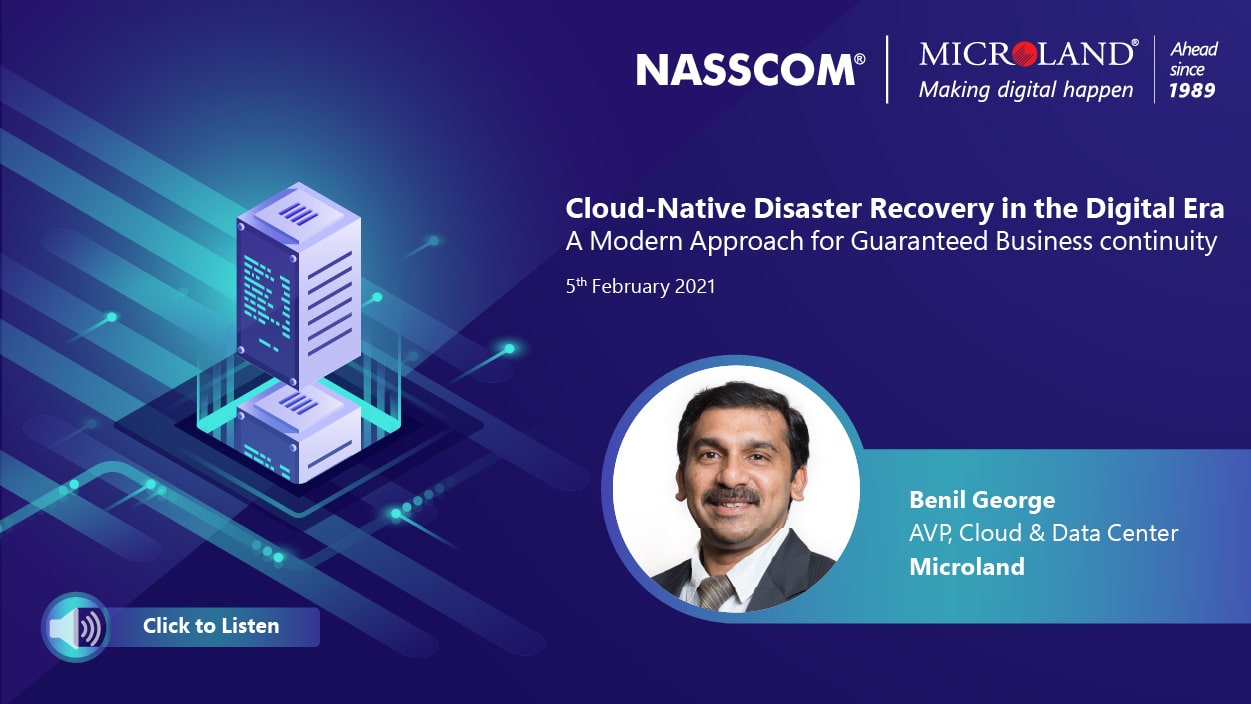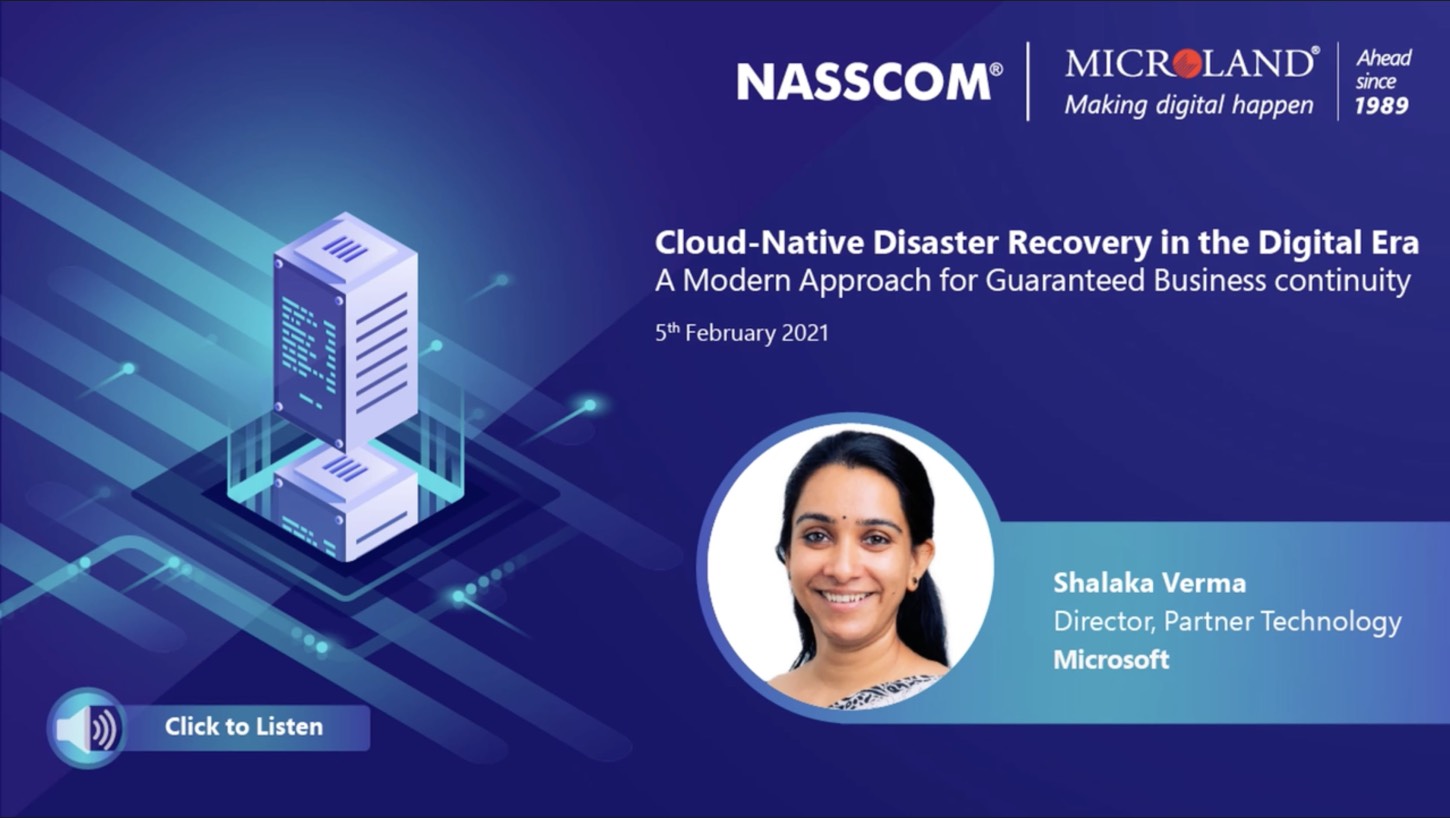 Feb 05, 2021
Feb 05, 2021 
Virtual Event – Cloud Native Disaster Recovery
Enterprises today need to deal with a double whammy –COVID and Disaster Recovery. With the steady increase in ransomware attacks, the need for pandemic-readiness and the availability of flexible models is making enterprises redraw their Disaster Recovery strategies to the Cloud. The investments with a focus on Public cloud-based Disaster Recovery (DR) options as opposed to the traditional on-premises, over-provisioned models are on the rise. Microland collaborated with NASSCOM as a Knowledge Partner hosting a virtual round table on February 5th, 2021—the topic “Cloud-native Disaster Recovery with Azure - A modern approach for guaranteed Business Continuity”. The agenda focused on a deep dive on perspectives on how enterprises are changing and transforming their Disaster Recovery strategy as a response to the imperatives of the new-normal.
This session provided insights on how Cloud-based DR helps enterprises expand their protection coverage and have more recovery points at lower costs, helping them recover from cyber-attacks or human errors with minimal RPOs and RTOs.
The informative and engaging conversation was made interactive through participation by Industry leaders and hosts from Microsoft and Microland. The speaker, Benil George, AVP, Cloud & Data Center – Microland highlighted the importance of multiple recovery points to evade disasters and emphasized on how DRs are to operate at very low scale and for shorter duration. Shalaka Verma, Director, Partner Technology – Microsoft spoke about experience in building and enabling many global enterprises with guaranteed, on-time recovery of business-critical workloads.







Key Event Takeaways
Challenges faced by enterprises in ensuring a cost-effective and secure DR strategy: The increase in disasters in the recent years due to ransomware based cyber-attacks has put organizations on the edge with heightened year-round preparedness. Data reveals that without the right DR solution, 90% of the organizations would not survive a disaster especially in the digital era where IT and Data are the backbone of businesses. The changing landscape of IT disasters, the recovery solutions for mitigating risks and the planning a DR strategy are today’s prime focus areas
Fully managed, automated, and secure recovery solution : The step-by-step DR plan consists of the precautions to minimize the effects of a disaster so the organization can continue to operate or quickly resume mission-critical functions. Typically, disaster recovery planning involves an analysis of business processes and business continuity needs. Before generating a detailed plan, an organization often performs a Business Impact Analysis (BIA) and Risk Analysis (RA), and it establishes recovery objectives. However, in the new approach, three new solution models take center stage making enterprises survive better. These included self hosted and managed, Colocated or 3rd party DC hosted and managed, and cloud hosted. Depending on the organization requirements and scalability, a solution model can be implemented.
Key challenges with DR Solution models: Most modern applications use resilient architecture to handle disasters such as distributed architectures and clusters with 70% of enterprise critical workloads not always aligned. Though they provide greater possibilities, they cannot be used for all workloads. Thus, the point of more coverage is not easily achievable – which during longer periods of disaster is very critical. The challenges can be addressed by a cloud native solution that provides the necessary ingredients such as highly available, fully managed DC infra, evolving DR tool, possibility of tightly integrating with other services enabling automation, the automation tools and all of this, in a pay-as-you-go model.
Key Benefits of Cloud Native Disaster Recovery:
- Lower costs: Cloud native DR provides just in time capability and lower storage costs .
- Guaranteed availability of DR infrastructure which could be scaled at will and for prolonged periods which is inherently provided by the cloud.
- Automation: DR tests and drills are expensive to run and the degree to which these can be automated on cloud is high. The tools that natively integrate to the cloud fabric and its services include automated runbooks, DNS changes, traffic redirections, sequencing of VMs, checks, test result checks and re-protecting or actual failover and failback automation.
- Savings: Focus on the Cloud native DR, automatically means focus on applications and data than maintaining the underlying DR infra and the DR orchestration solution. This in tune offers significant cost savings.
Implementing Disaster Recovery using Azure’s native solutions to support enterprise business continuity: Azure offers an end-to-end backup and disaster recovery solution that is simple, secure, scalable and cost-effective—and can be integrated with on-premise data protection solutions. In the case of service disruption or accidental deletion or corruption of data, it offers the ability to recover your business services in a timely and orchestrated manner. The Azure backup and disaster recovery solution is simple to architect, cloud-native, highly available and resilient.
IT challenges in implementing Business Continuity
- Cost - The cost of DR solution can often be prohibitive with the need for a second site, more people, more hardware and faster networking
- Complexity – Apart from the complexity to manage multiple data centers and their associated processes, the need to manage, patch, and upgrade the business continuity programs also becomes critical.
- Coverage – Only a few applications are covered with DR and not every application is backed up
- Compliance – The ability to be compliant across statutory and client contracts is equally critical
Please submit the following details to get in touch with our events team.







